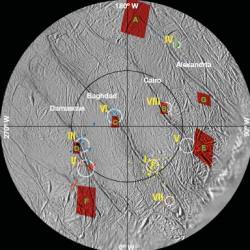Saturn’s moon Enceladus is one of the most peculiar objects in the Solar System. We now know there are geysers of water ice blasting from its southern pole; a place marked with long gashes that researchers have dubbed “tiger stripes”. Ever since the geysers were first discovered, scientists have been puzzling out their source. Now they understand how the geysers and tiger stripes are linked.
New research by the Cassini imaging team, CICLOPS, shows that the jets of Enceladus emanate from its southern pole, pouring out of four of the tiger stripes. The researchers have named them Alexandria, Cairo, Baghdad and Damascus. Of the four, Baghdad and Damascus are the most active and Alexandria is the least.
By taking Cassini’s two-year observations of the jets that spray from the surface, and combining this with thermal imaging of the stripes, the team was able to determine that the jets were spraying vertically out of the stripes, which are cracks on the surface of Enceladus.
The water sprays through the cracks because the gravity of Saturn pulls and pushes on Enceladus, and this motion – called a tidal force – heats up the frozen water underneath the surface. Much like geysers on Earth, the water is heated and expands below the surface, and follows the easiest path it can find to escape; this path happens to be right through the tiger stripes on the surface.
The researchers noted that when the tidal pull of Saturn was compressing this region of Enceladus, the geysers were not very active, if at all. But when the tides pulled and created tension, they began to erupt. Also, the hotter the region was, the stronger and larger the jet plume tended to be.
There may be other areas of Enceladus capable of producing jets, and now that the origins of the geysers are confirmed, more thermal and digital imaging of the surface could reveal other geysers in the future.
The researcher paper, entitled “Association of the jets of Enceladus with the warmest regions on its south-polar fractures” was published in the October 11th edition of the journal Nature.
Source: Nature

